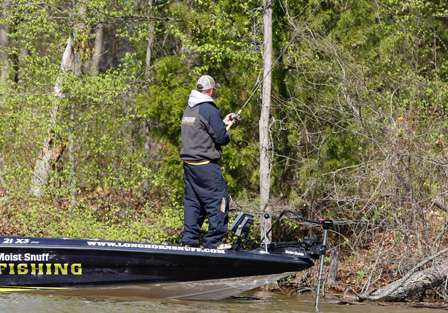
Photos | Standings | Live coverage | Archive
DECATUR, Ala. — Jared Lintner would have preferred to throw a spinnerbait or crankbait on Day Two of the Evan Williams Bourbon Dixie Duel, but found that the very reason why it was a fine day for flipping also made the topwater technique a mess.Rising water on Lake Wheeler had brought the water level up the banks, to bushes and laydowns. The high river also brought with it piles of floating debris, and leaves and sticks would hang on his every crankbait cast.”They’re not gonna bite that,” said Lintner, one of 100 Bassmaster Elite Series pros to fish in northwest Alabama this week. So he went flipping to get the 11 pounds, 8 ounces that allowed him to slip into the 50-cut in a tie for 49th with Kevin VanDam. “High, rising water and muddy?” Lintner said. “The fish go right to the bank.” So up and down the leaderboard, out came the flippin’ sticks.Flipping as a technique allows an angler to present a jig or a plastic bait in an almost horizontal fashion, the better to cast with precision. Anglers use it often when they want to cast beneath cover or to present a lure with minimal disruption to the water It’s a springtime deal when the water warms up,” angler Kevin Short (33rd, 23-11) said. He caught a 15-10 limit anchored by a 6-5 kicker by flipping throughout Day Two, mostly to bushes, logjams and beneath brush piles. He said the fish seek the warmth and shade beneath sun-beaten piles at the backs of creeks.Bill Lowen, an inveterate river fisherman, said the day could have been better for a flipping bite, though that’s the technique he favored on Day One as well as Day Two. With the water up about a foot and a half since midweek, Lowen said, “the fish got shallower and shallower and shallower.”But it was also “too much too fast.” The fish were somewhat agitated. Still, with vines and limbs clogging the banks, Lowen (20th, 25-7) stuck to flipping a tube.Jami Fralick (52nd, 22-1) watched his flipping bite turn on quite late as the sun warmed the shallow water. After struggling most of the day, he watched the shad move up to the newly submerged bushes along the bank, and he was able to cull three times in the last half-hour.”Yesterday, most fish were in 6 inches of water,” Fralick said. “The targets were isolated. Now all the bushes have enough water around them. It didn’t matter what you flipped in there. The water’s off-color enough now, if you just put it near them, they bite.”Like Fralick, Kevin Wirth (54th, 21-14) barely missed the cut sticking to a flipping bite. He had his limit by 9:30 a.m., but couldn’t find any large fish.He read the situation thus: The fish in Wheeler are accustomed to the water rising and falling, so they’re patient when the water’s low and don’t bum-rush the banks when the water rises incrementally. Earlier in the week, the water was hung in a middle range, leaving the fish in “no-man’s land.” There’s not much for the fish to populate just off the banks — the milfoil that used to thrive here is gone — and the fish scattered vThey have nothing in between to hold on,” Wirth said. So he looked for places where the water had already reached some kind of cover, but had in the past couple of days had gone from 1-foot deep to 3-feet deep. “Usually, this time of year, (flipping) is better for quality,” he said. But he was stuck with quantity.That wasn’t the case for everyone. Leader Tommy Biffle admitted only that he was doing “a little bit of everything” to catch his fish, including a tournament-high 19-7 bag on Day Two. But he admitted he was thrilled at the rising water and the sunshine — perfect flippin’ conditions.
Photos | Standings | Live coverage | Archive
